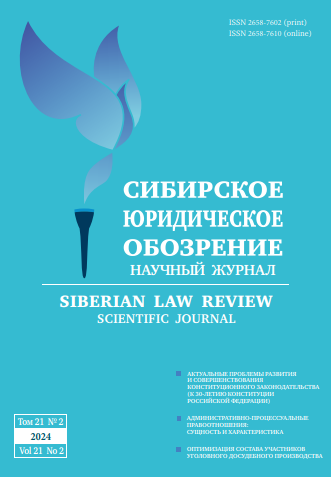Zemstvo Self-Government in Eastern Siberia
- Autores: Tarabara D.O.1
-
Afiliações:
- Saint-Petersburg State University
- Edição: Volume 21, Nº 2 (2024)
- Páginas: 142-155
- Seção: THEORETICAL AND HISTORICAL LEGAL SCIENCES
- ##submission.datePublished##: 21.10.2024
- URL: https://journal-vniispk.ru/2658-7602/article/view/348729
- DOI: https://doi.org/10.19073/2658-7602-2024-21-2-142-155
- EDN: https://elibrary.ru/FRGLLH
- ID: 348729
Citar
Texto integral
Resumo
The article focuses on the project aimed at implementing zemstvo self-government in the provinces and regions of Eastern Siberia, formulated by the Tsarist government in 1916–1917. The research draws upon documents from the Russian State Historical Archive, with some being presented in scientific discourse for the first time. Based on a comparative analysis of the reform proposed by representatives of the higher East Siberian bureaucracy and the draft law developed by the Ministry of Internal Affairs, it is concluded that there are two directly opposite approaches to the implementation of reforms. Emphasis is placed on the fact that regional authorities placed greater focus on the geographical, demographic, and socio-economic characteristics of Eastern Siberia, whereas central authorities prioritized the overarching framework for establishing a system of local governance and self-government, aligning with the prevailing theoretical principles of municipal law of that era. A study of the government bill on the management of zemstvo in the provinces of Yenisei and Irkutsk and in the Yakut region showed that it was an attempt to adapt the Zemstvo situation of 1890 to the conditions of one of the outskirts of the Empire, the specifics of which consisted in the absence of noble institutions and the weak development of private land ownership. Through a formal legal analysis, the strengths (such as decentralization of local self-government and transfer of resettlement management infrastructure to zemstvo institutions) and weaknesses (such as high property qualifications for voting unsuitable for the region and limitations on the competence of zemstvo self-government) of the government's proposed reform were identified. Examining the draft law for the implementation of zemstvo in the Irkutsk Governorate within the broader context of other government reform projects for zemstvo self-government from 1906 to 1917, which aimed at both substantial alterations to the existing zemstvo system and its expansion into "non-zemstvo" regions, provided insights into the prevailing perspectives of the highest bureaucratic echelons in the early twentieth century regarding the genesis and appropriate structuring of local self-governance. This, in turn, facilitates a deeper comprehension of the internal rationale behind its legislative endeavors and, consequently, the boundaries of the reform undertaken by the pre-revolutionary government.
Sobre autores
Dmitry Tarabara
Saint-Petersburg State University
Autor responsável pela correspondência
Email: tarabara@list.ru
ORCID ID: 0009-0006-0612-2510
Código SPIN: 9905-5048
postgraduate student
Rússia, 7–9 Universitetskaya Embankment, St. Petersburg, 199034Bibliografia
- Al’tshuller M. I. Zemstvo in Siberia. Tomsk: P. I. Makushin’s Bookshop Publ.; 1916. 411 p. (In Russ.)
- Petrushin Yu. A. (Ed.). Irkutsk and the Irkutsk People in the First World War: Research and Materials. Irkutsk: Ottisk Publ.; 2014. 448 p. (In Russ.)
- Shilovskii M. V. (Ed.). The History of Public Self-Government in Siberia in the Second Half of the XIX - Early XX Century. Novosibirsk: Sova Publ.; 2006. 351 p. (In Russ.)
- Compilation of Articles on Zemstvo in Siberia: Materials Exploring the Approaches Adopted By Local Administrations and Legislative Bodies in Addressing the Issue. St. Petersburg, 1912. 160 p. (In Russ.)
- Tresvyatskii L. A. The Public and Local Self-Government of Eastern Siberia at the Beginning of the Twentieth Century. Tomsk: Tomsk Polytechnic University Publ.; 2010. 184 p. (In Russ.)
- Trigub G. Ya. Local Government in the Far East of Russia in the End of the XIX - Beginning Of The XX Centuries. Vestnik of the Far East Branch of the Russian Academy of Sciences. 2006;5:150-155. (In Russ.)
- Ugryumova M. V. The Zemstvo Question and Zemstvo Self-Government in the Tobolsk Province (the Second Half of the XIX Century - 1919). Nizhnevartovsk: Nizhnevartovsk State Humanitarian University Publ.; 2007. 202 p. (In Russ.)
- Shilovskii M. V. The Draft of the Ministry of Internal Affairs on the Introduction of Zemstvo Self-Government in Siberia (December 1916). In: Problems of the History of Local Government in Siberia of the XVI-XXI Centuries. Part 1. Novosibirsk: The State Archive of the Novosibirsk Region Publ.; 2003. P. 86-89. (In Russ.)
- Yurtsovskii N. S. Zemstvo in Siberia: Zemstvo in Siberia: with the Law of June 17, 1917 and Excerpts from the Law of May 21, 1917. Tobolsk: Governmental Printing House, 1917. 50 p. (In Russ.)
- Veselovskii B. B. Zemstvo in Western Siberia. Zemstvo Business. 1916;22:943-949. (In Russ.)
Arquivos suplementares












